Pogostemon cablin Benth. - syn. Pogostemon patchouly Pelletier - Lamiaceae - patchouli, patchouly, Indisches Patschuli
Aromatic perennial herb, up to 1m high; native from India to the Philippines and Malaysia, now extensively cultivated throughout the tropical regions of Asia.
„The heavy and strong scent of patchouli has been used for centuries in perfumes (with oriental and masculine notes) and, more recently, in incense, insect repellents, and alternative medicines.“ http://en.wikipedia.org/wiki/Pogostemon_cablin
„Indian patchouli and its relative Javanese patchouli are grown to recover patchouli oil from the leaves by steam distillation as raw material for the perfume industry.“
http://de.wikipedia.org/wiki/Indisches_Patschuli
„The analysis of odour components in … Patchouli Oil (Pogostemon cablin Benth.) based on GC-, GC-FTIR- and GC-MS-data resulted in the identification of … (−)-patchoulol, α-guaiene, α-patchoulene, seychellene, α-bulnesene, norpatchoulenol and pogostol in Patchouli Oil as the most intense aroma compounds of these oils.“
[GC-FTIR and GC-MS in odour analysis of essential oils., Nikiforov, A., Jirovetz, L., Buchbauer, G., Raverdino, V., Microchimica Acta, Vol.95(1-6), 1988, 193-198]
Rotundone is a trace constituent of patchouli oil with impact on its scent due to its very low recognition treshold value.
[Meaningful Scents around the World, Roman Kaiser, Zürich 2006, 63]
Main components of supercritical CO2 extracts of patchouli leaves from Brazil (yield 0.44-5.0%) were β-patchoulene (1.6-3.2%), β-caryophyllene (3.1-5.8%), α-guaiene (13.3-24.1%), α-patchoulene (4.5-6.2%), seychellene (1.7-2.3%), δ-guaiene (= α-bulnesene, 15.5-21.1%), and patchoulol (12.9-32.2%).
[Comparison of extraction of patchouli (Pogostemon cablin) essential oil with supercritical CO2 and by steam distillation., Donelian, A., Carlson, L.H.C., Lopes, T.J., Machado, R.A.F., The Journal of Supercritical Fluids, 48(1), 15-20, 2009]
„The important oil components which are considered for the fragrant and medicinal activities of the oil are patchouli alcohol, α-bulnesene, α- and β-patchoulene… The oil of Pogostemon cablin [0.3% f.w.] was rich in α-patchoulene (3.3%), β-patchoulene (4.2%), patchouli alcohol (23.2%) and α-guaiene (14.6%).“
[Composition and comparison of essential oils of Pogostemon cablin (Blanco) Benth.(Patchouli) and Pogostemon travancoricus Bedd. var. travancoricus., Sundaresan, V., Singh, S.P., Mishra, A.N., Shasany, A.K., Darokar, M.P., Kalra, A., Naqvi, A.A., Journal of Essential Oil Research, 21(3), 2009, 220-222] http://staff.cimap.res.in/PublicationFiles/JEOR.pdf
„The primary fragrance molecule in the essential oil is the sesquiterpene alcohol norpatchoulenol, which is present at 0.35-1.0% or less.“
[Flavours and Fragrances: Chemistry, Bioprocessing and Sustainability. Ralf Günter Berger, Springer 2010]
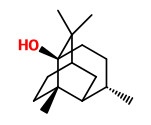 (−)-patchoulol (typical patchouli, th 0.93ng/l air) | 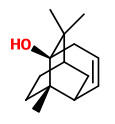 (+)-norpatchoulenol (typical patchouli, th 2.8ng/l air) | 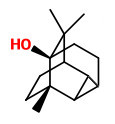 (+)-nortetracyclopatchoulol (typical patchouli, th 1.0ng/l air) |
Major constituent of the essential oil produced by steam distillation of the dried leaves is (-)-patchoulol (patchouli alcohol, 23.6-45.9%), whereas (+)-norpatchoulenol comprises only 0.5%.
„The dispute about the olfactory properties of (-)-patchoulol was settled by Näf et al. by the stereoselective synthesis of both enantiomeric forms of (-)-patchoulol, which established (the molecule) to possess a typical patchouli note… whereas the non-natural ent(+)-enantiomer has a much weaker odor, and is not reminescent of patchouli oil… while (+)-norpatchoulenol was about three times less potent with an odor treshold of ca. 2.8ng/l air… The approximate treshold figures are due to vastly diverging sensitivities and a large number of anosmias for patchouli odorants. The inability of many people to smell some of the patchouli odorants may well have caused the dispute in the first place.“
[Scent and Chemistry, Günther Ohloff, Wilhelm Pickenhagen, Philip Kraft, Wiley-VCH, 2012]
When the headspace, rather than the oil, is subjected to GC analysis, a series of highly volatile compounds that have never been described in patchouli oil were found to be significant contributors to some of the odour nuances of patchouli oil. Compounds included 2-ethyl furan, 4-ethenyl-2-methoxyphenol (4-vinyl guaiacol), ethyl 4-methylvalerate, (4S,4aS,8aR)-4,8a-dimethyl-1,2,3,4,5,6,7,8-octahydronaphthalen-4a-ol (geosmin), 4-ethyl-2-methoxyphenol (4-ethyl guaiacol), 4-ethyl phenol, 2,6,6-trimethylcyclohexa-1,3-dienecarbaldehyde (safranal), 3-propyl phenol, iso-butyl methoxy pyrazine, 2-methoxy-3,6-dimethyl pyrazine, and 1,2,7,7- tetramethylbicyclo[2.2.1]heptan-2-ol (2-methyl isoborneol).
[Givaudan, Perfume compositions, World Patent 2017/050971, September 24, 2015] https://encrypted.google.com/patents/WO2017050971A1
Average concentration (GC, internal normalisation) of major patchouli constituents based on over 100 patchouli oils were e.g. (ranges and ISO 2003 norm in parenthesis): patchoulol 39% (11-72%, ISO 27-35%), norpatchoulenol 0.86% (0.11‐4.0%, ISO 0.35-1%), α‐bulnesene 14% (2.9‐23%, ISO 13-21%), α‐guaiene 11% (2.9‐23%, ISO 11-16%). (+)-Nortetracyclopatchoulol „…is not necessarlily a 0.001% trace constituent but can occur at concentrations of 0.5% or higher. Therefore, in some oils it might contribute significantly to the overall patchouli odour… The presence of rotundone in PEO [patchouli essential oil] is not surprising since it has been shown to be readily produced by aerial oxidation of α‐guaiene… The detection thresholds measured for the three closely related tertiary alcohols are important parameters to consider when discussing their odour value and relative contributions: (−)‐patchoulol ~0.93 ng/L air, (+)‐norpatchoulenol ~2.8 ng/L air, (+)‐nortetracyclopatchoulol: ~1.0 ng/L air…Pogostol has been mentioned once as one of the major contributors to the woody odour of PEO but this seems somewhat doubtful… Cis- and trans-pentylcyclopropane carboxylic acids, respectively cis-2-pentylcyclopropanecarboxylic acid and trans-2-pentylcyclopropanecarboxylic acid, are potent odour contributors: when isolated, the cis-isomer, which occurs in the essential oil at ~200 ppm, is claimed to possess a 'patchouli-like, animal, leathery note with good intensity and persistence'. The contribution of pogostone (syn. dhelwangin) that occurs - like its minor analogs - in variable concentrations in PEO, has not been reported so far, and is therefore supposed to be negligible or nil.“
[van Beek TA, Joulain D. The essential oil of patchouli, Pogostemon cablin: A review. Flavour Fragr J. 2017;1-45]
http://onlinelibrary.wiley.com/doi/10.1002/ffj.3418/pdf
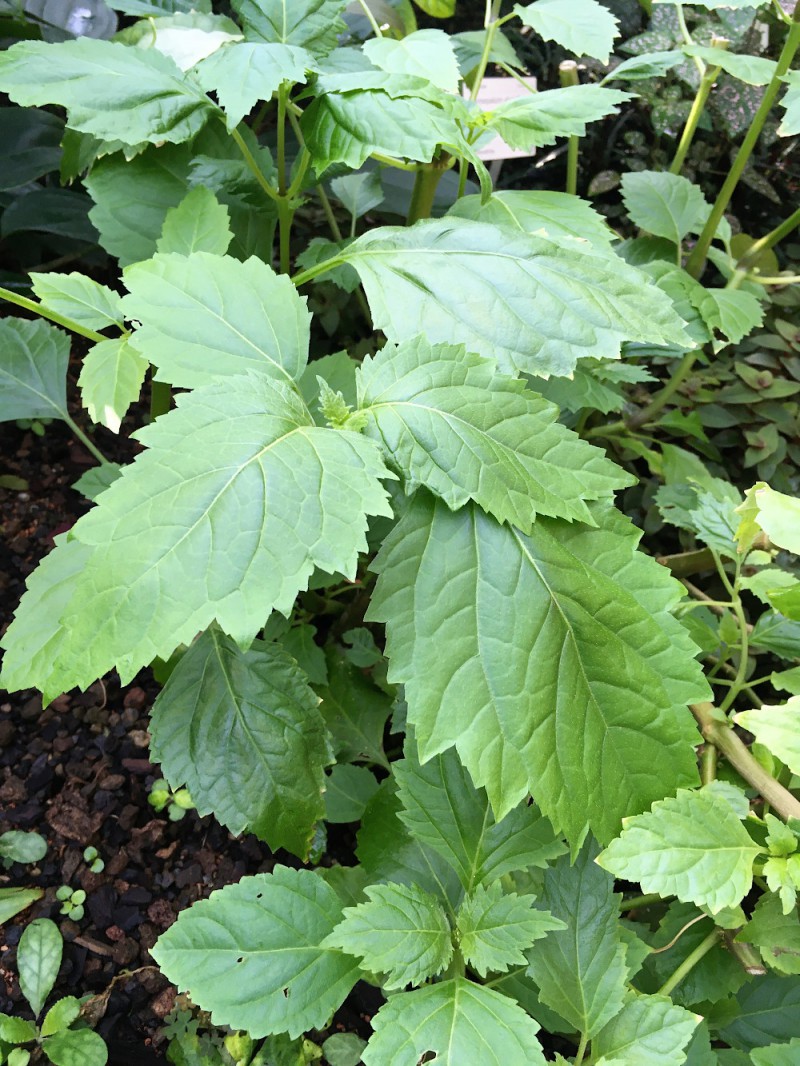
Pogostemon cablin. Gruson Gewächshäuser Magdeburg (2022)
CC BY-SA 3.0, Author: Andreas Kraska
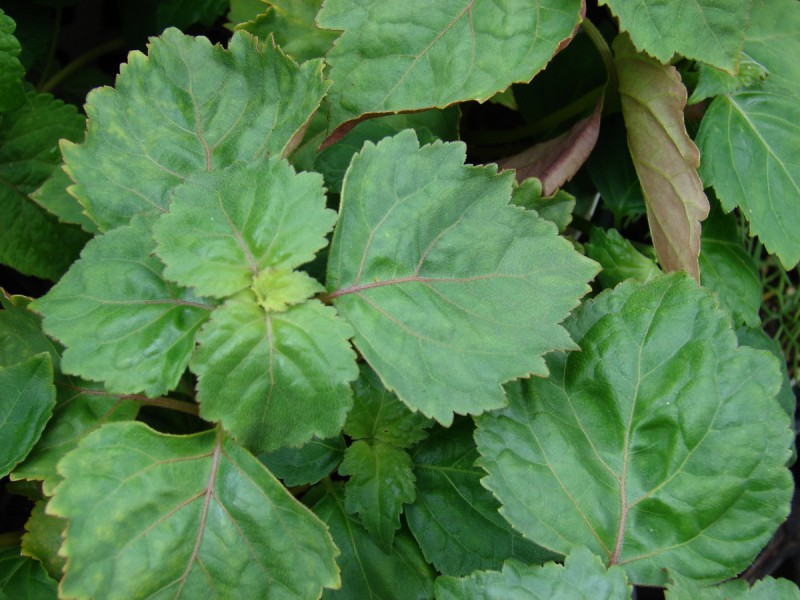
Pogostemon cablin (leaves). Maui, Kula Ace Hardware and Nursery
CC BY-SA 3.0, Author: Forest & Kim Starr Wikimedia Commons
